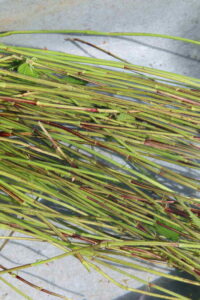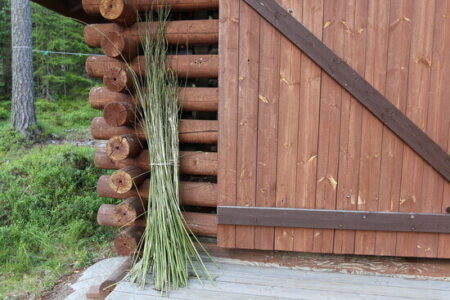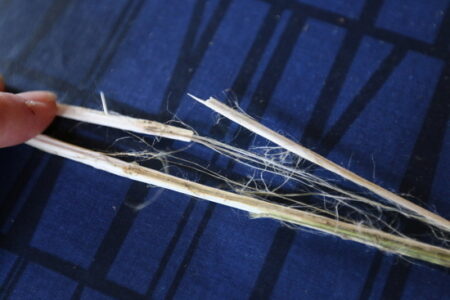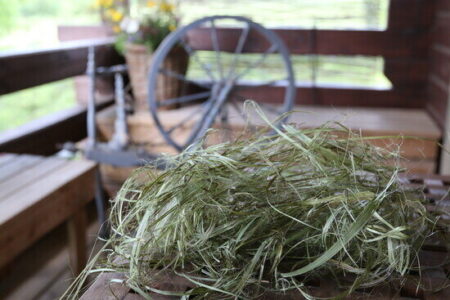Hidden in a weedy patch in your backyard, or on the forest edge, lies a humble plant that is most famous for its burning sting. But did you know that stinging nettle (Urtica dioica) can also be used for making textiles? Inside the plant’s stalks are long, strong, fine fibers. Surprisingly, nettle is anything but harsh when woven into fabric: nettle cloth is lustrous and smooth, similar to linen but even stronger.
Nettles have been used for textiles at least since medieval times. Along with flax and hemp, nettle was the most important plant-based textile material in Europe because, unlike cotton, it grows even in northern climates. Commercial nettle fiber farming started in the nineteenth century. During the First World War, with sanctions imposed on cotton, the German army used nettle fabric for their soldiers’ uniforms.
Now we see a resurgence of interest in nettle-based textiles within the sustainable fashion industry. Nettle fiber is a promising alternative for sustainable fashion for many reasons:
New spinning technologies, plant cross-breeding, and growing concerns over the environmental costs of conventional cotton-growing make nettle a viable alternative for eco-textile companies.

But it’s also possible to grow, harvest and process your own nettle fiber on a home scale. Given how common stinging nettle is in temperate climates, you shouldn’t have too much trouble finding the nearest nettle patch — or growing your own, as I have done.
I first learned harvesting and processing nettle fiber when visiting my family in Finland. The stinging nettle in Finland is the same Urtica dioica, European nettle, that also grows in most of North America. My great-grandparents grew flax for clothing on our family farm. Now the flax fields are gone, but stands of stinging nettle are still abundant. I had used nettles as food, medicine, and dye, but once I learned about their potential for flax-like fiber plants, I had to give it a try.
I did the entire process by hand, as it’s traditionally done. It takes patience, and some experience working with fibers helps, but anyone can do it following the step-by-step instructions below.

Nettle Fiber Processing
The steps for processing nettle for textiles are similar to processing flax. The key is softening the nettle’s woody stalks in order to be able to extract the fibers within.
- Collect nettles and remove the leaves
- Soak the nettle stalks (a process called retting) for at least one week to break down the cellulose surrounding the fibers so the fibers can be extracted
- Dry the nettles out in the sun, in a greenhouse or a sauna
- Break the dried-up stalks by hand to separate the fine fibers from the woody pith
- Scutch and hackle to further soften the fibers
- Spin the fibers into yarn
The only stings I got in this process were during the initial harvesting. Once the nettle stalks have been soaked and dried, the stinging hairs are gone. The fibers themselves are beautiful — light linen-colored, and very soft and strong.
Harvesting Nettles
Harvest from August onwards, when the plants have reached their optimal height but have not yet begun to die down. Cut the stalks near the ground with pruning shears and remove the leaves. For this stage, you do want to wear gloves and long sleeves! The leaves make excellent compost.

Retting Nettles
Retting the nettle stalks can be done in a few different ways. As with flax or hemp, nettle stalks could simply be laid on the ground for a couple of weeks. The morning dew and the soil microbes will break down the woody plant matter and dissolve the pectin and the lignin that make the fibers stiff and bind them to the stalk.
The process can be expedited by soaking the nettles in any large enough vessel such as a wheelbarrow, a kiddie pool, or livestock water tank. I soaked mine the way flax is traditionally retted in Finland: in a lake, weighed down by pieces of wood and held in place by the tall sedges.
When the plant matter starts to have that earthy smell of plant matter breaking down, i.e. rotting, it is time to remove them. This will take about a week.

Dry the Nettle Stalks
The next step is to dry the stalks completely. This can be done in the sun, in a greenhouse, or in a sauna if you have access to one.
Break the Dried-Up Nettle Stalks

At this point, the dried-up stalks will snap easily, and you should be able to extract the fibers from the woody stem. After some experimenting, you’ll discover the best way to separate the fibers from the pith. If you squeeze the stalk flat until it splits, you can then run a thumb nail to lengthen the crack all the way to the end. Then it’s easy to break a piece of the pith off and pull it away, extracting the fibers.
If working on a large scale, it would make sense to try the traditional equipment for processing flax, such as a scutching knife and a hackling board.

Carding or Hackling Nettle to Further Soften the Fibers
At the end of the extraction process, you’ll have a bundle of wispy fibers. Some green plant matter (cellulose) from the nettle stalks will probably still adhere to some of the fibers. Again, traditionally a hackling board was used to soften the fibers. I used my hand carders for wool, combing the silvery green mass until the remaining chaff was removed.

Spinning Nettle Fiber
The final step is spinning the nettle fibers into thread. You don’t need a spinning wheel; a drop spindle works fine as well.
The actual spinning of the nettle fibers is comparable to spinning flax: the fiber lacks the crimp of wool and is somewhat slippery as a result. However, nettle fiber can easily be blended with other natural fibers to make it easier.
Holding in your hands your first fibers harvested from the wild, from a plant that does not need any human input to thrive, is an empowering experience. If you’re a spinner or a weaver, there’s no end to the unique pieces you could create. Some people even say that the medicinal qualities of nettle are transferred to textiles created from them: a shawl woven out of nettle fiber, for example, will soothe aching necks and shoulders.

Resources
Rebecca Burgess, Fibershed: Growing a Movement of Farmers, Fashion Activists, and Makers for a New Textile Economy (Chelsea Green Publishing, 2019)
- Startup Fashion, 2013
- Fashion United, 2017
- Yarn and Knitting, 2019
Mari Stuart lives in Asheville, N.C., where she stewards an urban homestead with her husband and daughter. She is a Certified Permaculture Designer and Teacher and a Certified Ecological Landscaper, who cofounded Project Grounded, an initiative that connects urban consumers to the regenerative agriculture movement through their daily choices. She is currently working to develop a pioneering community-supported carbon farming program in Western North Carolina.
All MOTHER EARTH NEWS community bloggers have agreed to follow our Blogging Guidelines, and they are responsible for the accuracy of their posts.




